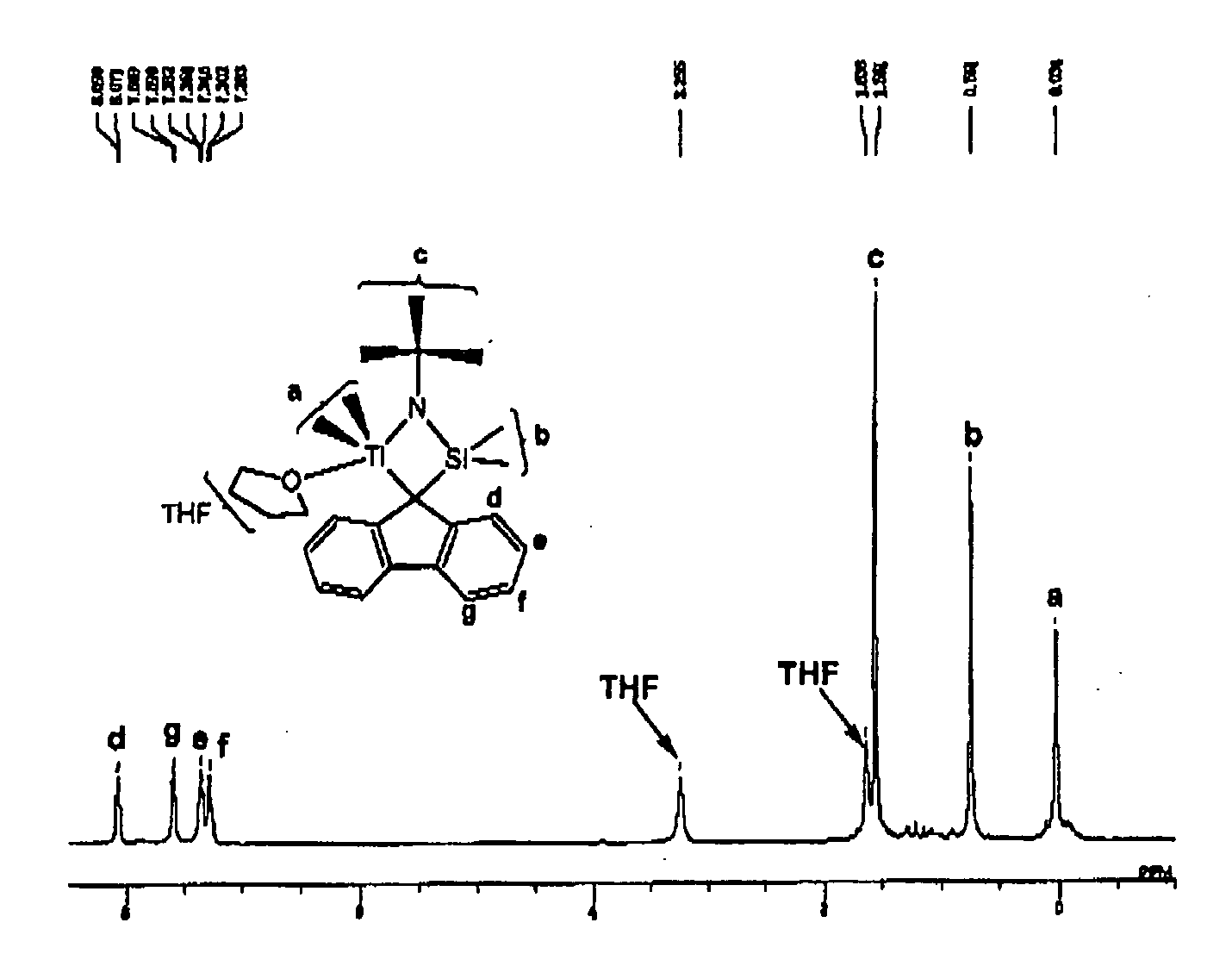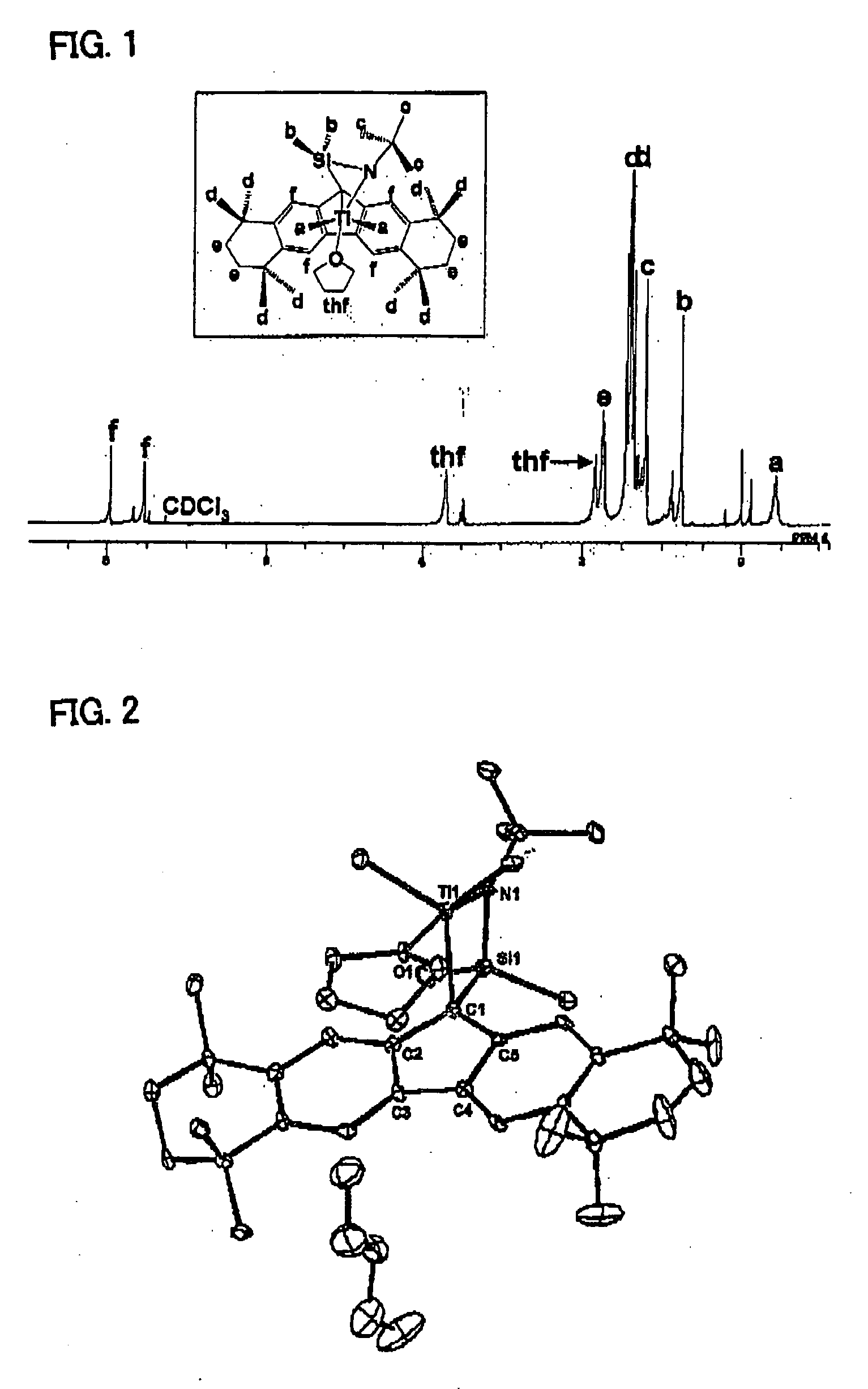Process for producing cycloolefin addition polymer, catalyst for addition polymerization of cycloolefin, and transition metal compound
a technology of cycloolefin and addition polymer, which is applied in the field of new products, can solve the problems of poor activity of addition polymerization of cycloolefin, insufficient industrial catalytic activity, and at all activity, and achieve the effect of improving efficiency
- Summary
- Abstract
- Description
- Claims
- Application Information
AI Technical Summary
Benefits of technology
Problems solved by technology
Method used
Image
Examples
example 1
Synthesis of Transition Metal Compound (A)
Synthesis of (t-butylamide)dimethyl-9-[octamethyloctahydrobenzofluorenyl]silanetitanium dimethyl(tetrahydrofuran) complex
Complex I
[0094]
[0095](t-butylamide)dimethyl-9-[octamethyloctahydrobenzofluorenyl]silane as a ligand was synthesized by the method described in Journal of the American Chemical Society, vol. 126, pp 16716-16717, 2004. 32 parts of the thus-synthesized ligand was placed in a glass reactor in a nitrogen gas atmosphere. To the content, 424 parts of diethyl ether was added, and the resultant solution was cooled to 20° C. To the solution, 8.06 parts of methyllithium was added, and the mixture was stirred at room temperature for 4 hours. The thus-obtained solution of a lithiated ligand in diethyl ether was incorporated in a previously prepared mixed liquid comprised of 7.60 parts of titanium tetrachloride and 130 parts of hexane at 0° C. The resultant mixture was stirred at room temperature overnight. The solvent was removed under...
example 2
Polymerization of 2-Norbornene
[0101]A glass reactor was charged with 130 parts of toluene, 18.8 parts of norbornene and 4.64 parts of modified methylaluminoxane (MMAO-3A; available from Tosoh Finechem Corporation) dissolved in toluene. 0.13 part of the complex I dissolved in 8.67 parts of toluene was added to the content in the reactor. The oil bath in which the reactor was placed was heated to 50° C. whereby the polymerization was commenced. The content was stirred for 1 minute to carry out the polymerization, and then the polymerization liquid was poured into a large amount of methanol acidified with hydrochloric acid to completely precipitate a polymer. The polymer precipitate was separated by filtration, and washed. Then the washed polymer was dried under reduced pressure at 80° C. for 15 hours to give 9.70 parts of polymer. The polymerization activity was 2.910 kg-polymer / (mol-Ti·h). The Mw and Mn of polymer could not be measured by GPC using tetrahydrofuran or chloroform.
example 3
Copolymerization of 2-Norbornene with 1-Hexene
[0102]A glass reactor was charged with 346 parts of toluene, 37.6 parts of norbornene, 8.40 parts of 1-hexene and 2.32 parts of modified methylaluminoxane (MMAO-3A; available from Tosoh Finechem Corporation) dissolved in toluene. 0.06 part of the complex I dissolved in 8.67 parts of toluene was added to the content in the reactor. The oil bath in which the reactor was placed was heated to 50° C. whereby the polymerization was commenced. The content was stirred for 5 minutes to carry out the polymerization, and then the polymerization liquid was poured into a large amount of methanol acidified with hydrochloric acid to completely precipitate a polymer. The polymer precipitate was separated by filtration, and washed. Then the washed polymer was dried under reduced pressure at 80° C. for 15 hours to give 13.7 parts of polymer. The polymerization activity was 1.644 kg-polymer / (mol-Ti·h). The Mw of polymer was 152,400 and the Mn of polymer wa...
PUM
 Login to View More
Login to View More Abstract
Description
Claims
Application Information
 Login to View More
Login to View More - R&D
- Intellectual Property
- Life Sciences
- Materials
- Tech Scout
- Unparalleled Data Quality
- Higher Quality Content
- 60% Fewer Hallucinations
Browse by: Latest US Patents, China's latest patents, Technical Efficacy Thesaurus, Application Domain, Technology Topic, Popular Technical Reports.
© 2025 PatSnap. All rights reserved.Legal|Privacy policy|Modern Slavery Act Transparency Statement|Sitemap|About US| Contact US: help@patsnap.com



